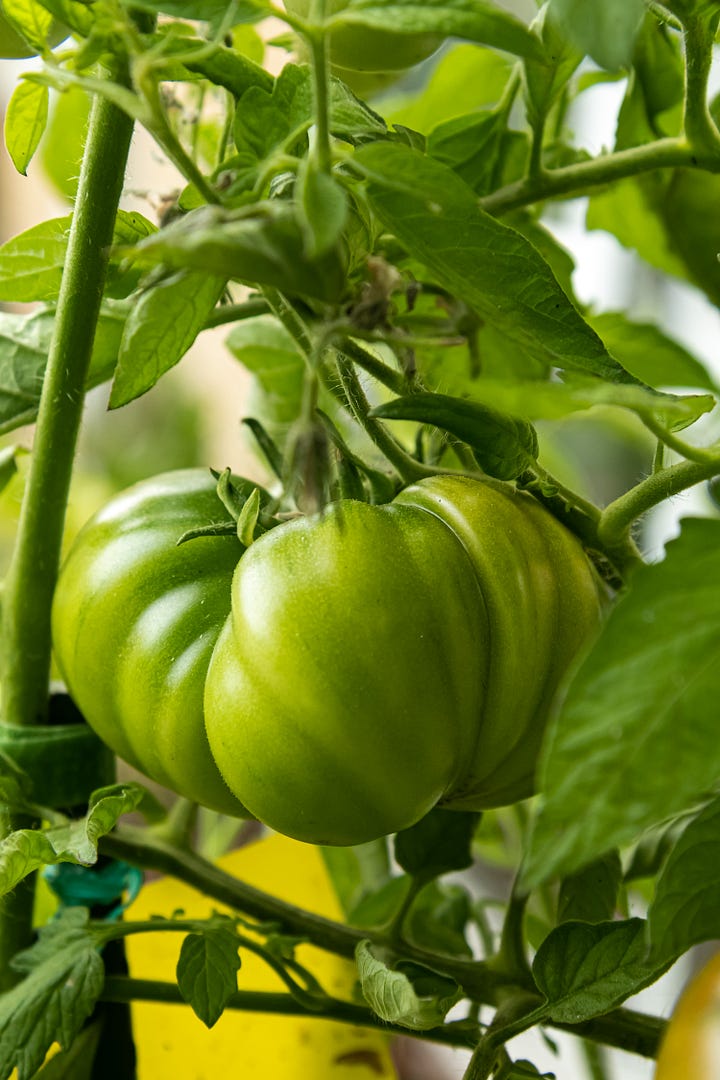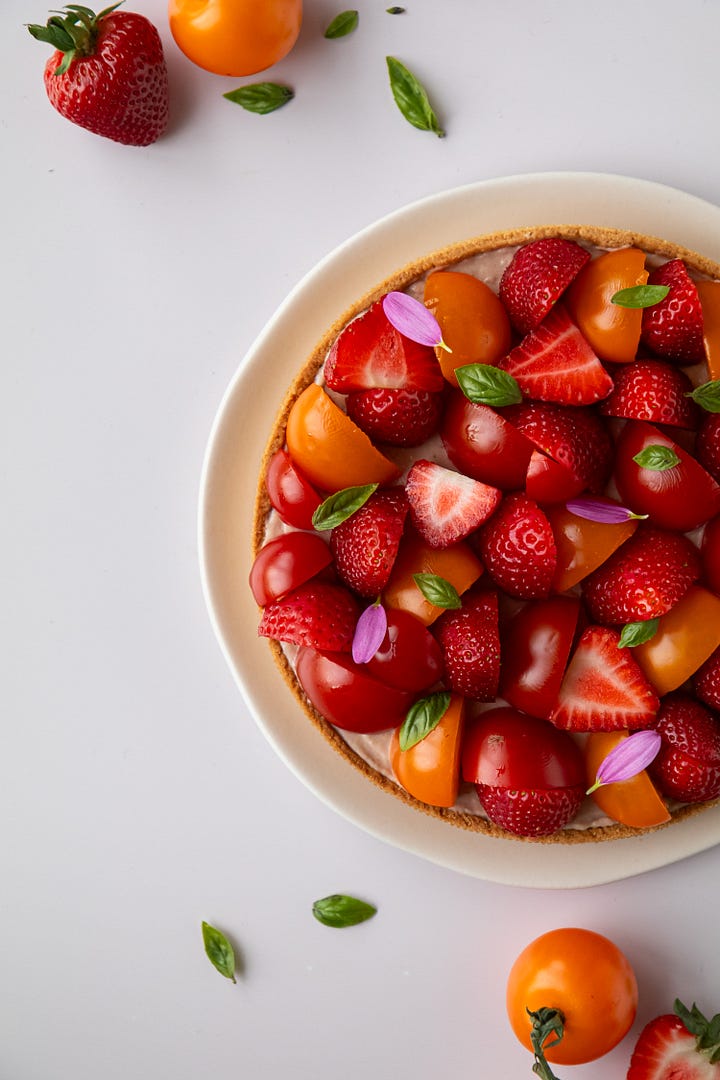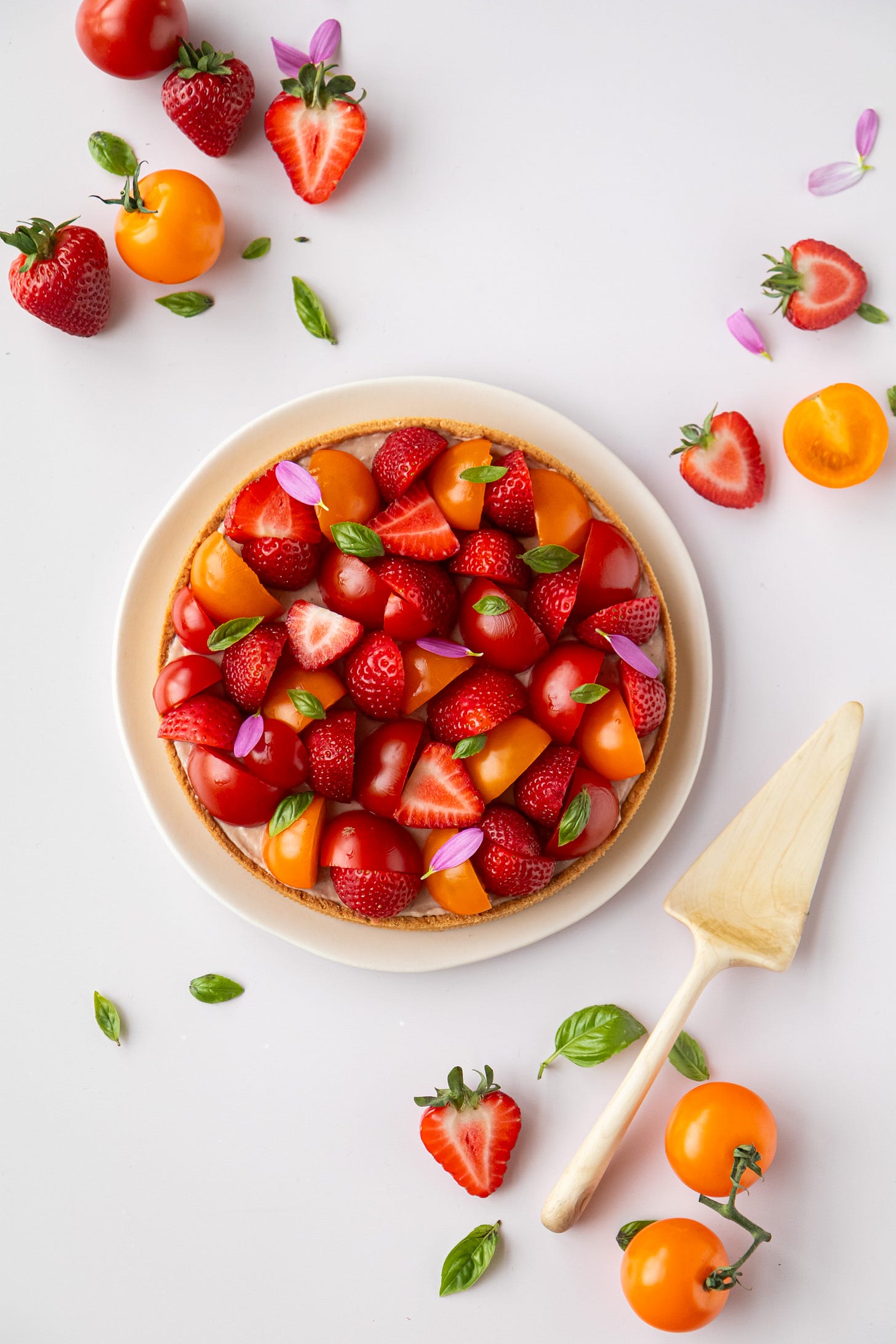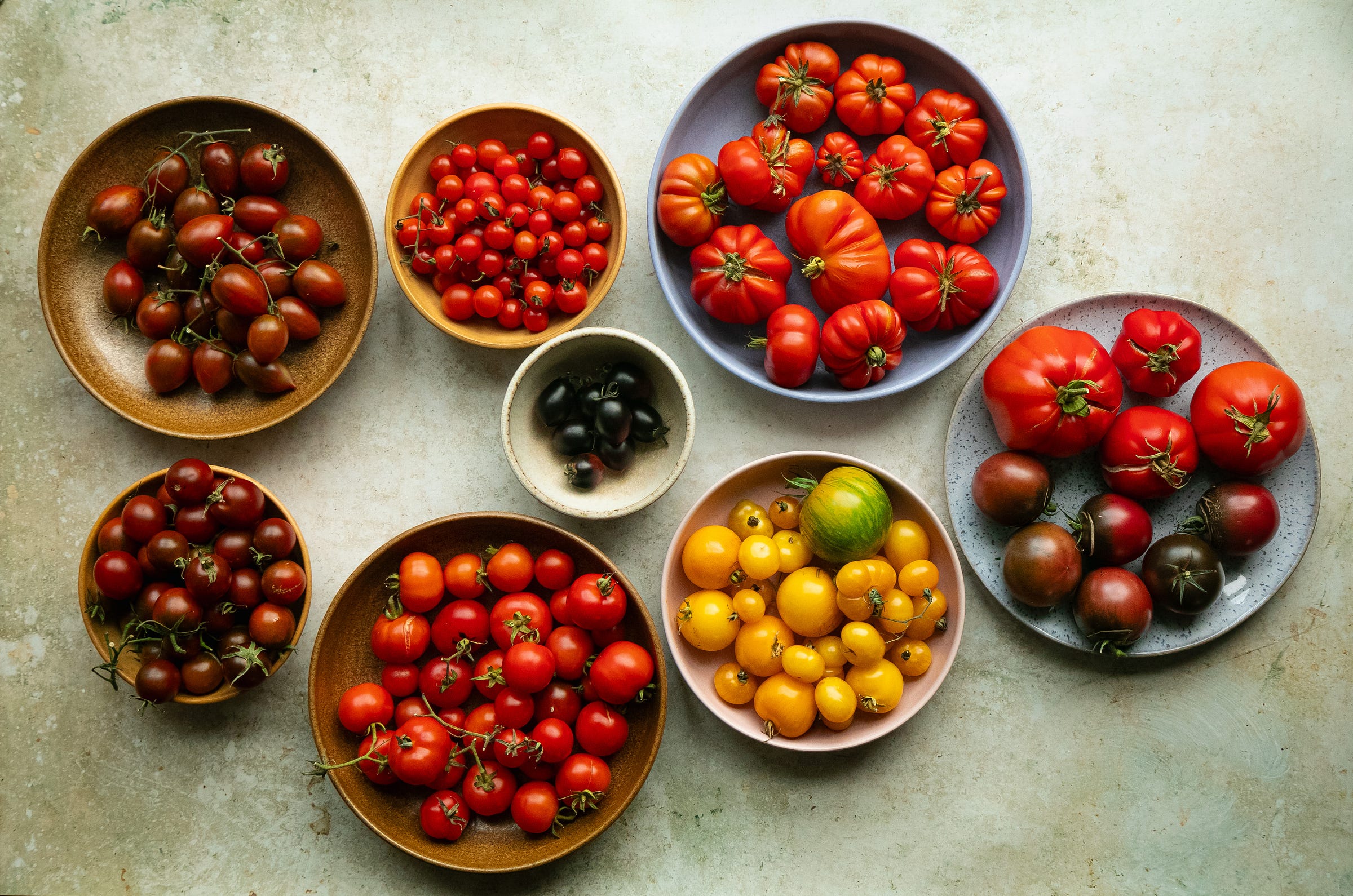Hello, and thanks for reading Latina Cooking. Most of my recipes are for paid subscribers. Could I tempt you to pay so I can share more content with you? It costs less than a pint a month, almost the same as one coffee a month. Sounds reasonable? Click below - it will take you to different subscription options, including becoming a free subscriber.
This week, I'm sharing my strawberry and tomato tart recipe. Over the past few years, I have been on a journey of sourcing ingredients that are as diverse as possible, and whose origins I know and trust. I have been on this journey aiming to use ingredients that truly support the farmers and nourish our bodies and soils. For various reasons, pursuing this goal in sweet cuisine can be more challenging than in savoury cooking, but it is definitely not impossible.
My partner and I have lived in Cambridge, UK, for seven years. Over these years, I have had a love-and-hate relationship with the town. Even though it is a stunning place to live, it was hard for me to make meaningful connections. We rented a house with a garden covered in concrete slabs. After a year or so we chose to remove the concrete slabs from our backyard and transform the barren surface into a lush garden, and everything changed. Under the concrete slabs, we discovered severely damaged soil that had likely been covered for several years. Rehabilitating the soil to grow flowers for pollinators and produce food for ourselves provided a sense of belonging that I had long been yearning for.
The first plants we started growing were lettuce, calendula flowers, peas, and tomatoes. At the time, I didn’t know much about growing plants, soil, or food systems. Despite not knowing much about what I was doing, it was during that time, in our back garden, where I found my place. I felt there was where I belonged, mainly because I had a tiny space where I could grow food, spend most of my time in the garden, and then cook with what I grew.
This feeling of belonging, especially as an immigrant, was something I was craving. I realized it wasn’t just growing our food that made me feel that sense of belonging; it was being able to be surrounded by nature that we grew from scratch that provided me with that special sense, even if that nature was a human-made garden.


One of the plants that I have enjoyed growing the most is tomatoes. The difference in flavour between homegrown tomatoes and store-bought ones is shocking. Homegrown tomatoes are so juicy, and sweet, and even the ones that don't turn out with the stereotype perfect shape are still gorgeous. Growing tomatoes in the UK isn’t straightforward. Growing tomatoes in the British weather can be quite challenging, mainly because the British summer season is unstable and sometimes, so short. Whenever I visit my hometown in Chile, I feel envious of their long sub-tropical summer season for growing tomatoes, where tomatoes are blessed with full sunshine and warm temperatures from September until March. I am always so jealous of my dad having orange seized tomatoes for about 6 months a year. This made me think about the origins of tomatoes, and guess what? They are from South America!

South American origins of tomatoes
The wild ancestor of the tomato, Solanum pimpinellifolium, is native to western South America, in the Andean region between Peru, Bolivia and north Chile. These wild versions were the size of peas. These pea-sized tomatoes, somehow reached far, further than what you may think. The first evidence of tomato domestication points to the Aztecs in Mesoamerica, who used this fresh fruit in their cooking. When the Spanish colonized America, tomatoes had long been growing in Central America’s soils. As expected, the Spanish were the first to introduce tomatoes into Europe as an exotic fruit from the new world. However, it took a while before tomatoes were loved in Europe and became the staple food they are now in many cuisines. Chronicles outline several reasons for Europeans initial rejection of tomatoes. Some of these reasons were witchcraft, lead poisoning and, interestingly, a mistake cataloguing the tomato as a solanum, which is a botanical genre of poisonous fruits. This Gastro Obscura article summarises the fear of Europeans of tomatoes in the 1700s. Nowadays tomatoes are widely consumed in every corner of the earth. Of course, the widespread consumption of tomatoes doesn’t come without issues. An interesting issue linked to the large demand for tomatoes worldwide is what happens with farmers’ insecurity in Italy (this article from Food Unfolded regarding the Italian Mafia involvement in the tomato market is a good introduction to the subject, as well as, this video).


Let us embrace diversity in our desserts
A tomato is never just a tomato... Even when you sift through the tangle of overgrown vines, gently caring for each available fruit before plucking the ripest specimen, you are only scratching the surface of the fruit’s background. You may have planted that tomato, but who grew the fruit that produced the seed you sowed? Who packaged that seed, shipped it to your door, or trucked it to the retailer from which you bought it? Who raised the cow that created the manure that amended the compost that fertilized the bed? Maybe you, did all these things yourself—in which case, wow!—but if you look closely enough, you’ll find gaps where another person’s work shines through the cracks. Most of the time those people in the value chains are invisible.
A good starting point is asking those questions; who grew this seed? who picked the tomato? and raising the value regarding the people behind our food. A plate of food has a big load of history behind it. This is why bringing diversity to our desserts and raising awareness of the people behind the ingredients is relevant and is one of the solutions to address climate change via food. Thinking of all the amazingly colourful and vibrant varieties of a tomato or a strawberry, instead of the boring tomatoes that might not have much flavour is also acknowledging the people that care enough to grow this diversity and about the people that eat this diversity.
It’s meaningful work to plant a seed, grow a plant, pick a tomato and cook with that tomato. By collectively cultivating our gardens, and saving seeds, we are cultivating community, feeding people, and fighting climate change, and this meaningful revolution can taste great, too.


Tomatoes and Strawberry tart
Sweet tart dough
Ingredients for 1 tart of 24 cms diameter
150 grams of unsalted butter (cold)
95 grams of icing sugar
30 grams of toasted ground almonds
1 gram of fine sea salt
60 grams of eggs
125 grams of all-purpose flour
125 grams of wholewheat flour
Method
Toast the ground almonds in the oven at 160C for 10 minutes for a more intense flavour. Let it cool down completely before making the dough.
Cut the butter into cubes. Mix the ground almonds, the icing sugar, the flours and salt.
Mix it with the butter, without overmixing (you can do this with the food processor with a few pulses or by hand) try not to overwork it. Add the eggs (add 30 grams first and check if it needs the extra 30 grams - this depends on the kind of flour you are using, sometimes the flour absorbs more liquid).
Once it is a homogeneous dough, wrap it between two baking papers and take it to the fridge for at least 5 hours.
Once the dough is cold and rested, prepare a tart mould with baking paper on the bottom and press the dough to the mould. Blind bake it for 15 minutes at 165C. (I put it first in the freezer for 15 minutes to ensure it won’t shrink once baked- I also recommend using these tart moulds as they are magic and you don’t even need baking beans).
After the 15 minutes, mix one egg yolk with 3 tbsp of milk brush it on the bottom and bake for 10 more minutes, until it is golden.
Mascarpone strawberry cream
125 grams of strawberry puree
110 grams of mascarpone cheese
4 grams of silver sheet gelatine
40 grams of light muscovado sugar
Method
Hydrate the gelatin sheets in icy water.
Heat the strawberry puree with the sugar to 40ºC. Squeeze the gelatin sheets taking the excess water and mix it with the puree and sugar mix.
Once it is well incorporated, fold the mascarpone, and let it rest for an hour in the fridge before using.
Tomatoes and vanilla jam
650 grams of red mature tomatoes (try to use different varieties of tomatoes)
2 vanilla pods
125 grams of light muscovado sugar
Juice of half a lemon
Pinch of salt
Method
To prepare the tomatoes, first, peel them by placing them in hot water for a few minutes to easily remove the skin. Then, cut the tomatoes into quarters and remove the seeds (save them to sow seeds and grow delicious tomatoes for next summer!)
Split the vanilla beans open, scrape out the seeds, and mix them with the tomatoes.
Combine the tomatoes with sugar, lemon juice, salt, and vanilla. Allow the mixture to marinate for two hours or overnight.
After marinating, strain the tomatoes. Take the strained liquid and simmer it until it thickens, then mix it back in with the tomatoes. Let the mixture cook for about 20 minutes. Finally, allow it to cool before using it.
Assembly
Once the tart dough is baked and cooled, spread a layer of cold jam over the base of the tart. Then, using a piping bag, fill the cake with the strawberry and mascarpone cream. Use a spatula to spread the cream evenly over the entire tart. Cut tomatoes of different colours Diversity! and strawberries (I wish that when I did this I went a bit more crazy with the tomato varieties, but if you can go wild with diversity) and use them to decorate the tart, covering the entire surface or as desired.
The tart is best enjoyed the same day it is baked, but it can be stored for up to 3 days in a sealed container in the refrigerator.








In love with the warmth in your photos! So many beautiful varieties!
So good. Off to make tomato jam now. Thank you x